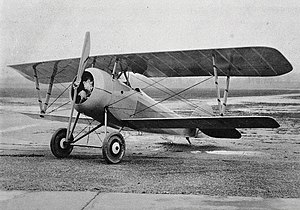Loading AI tools
French WW1 fighter aircraft From Wikipedia, the free encyclopedia
The Nieuport 27 (or Nieuport XXVII C.1 in contemporary sources) was a World War I French sesquiplane fighter aircraft designed by Gustave Delage. The 27 was the last of the line of Nieuport "V-strut" single seat fighters that began with the Nieuport 10 of 1914. Operational examples supplemented the very similar Nieuport 24 and 24bis in operational squadrons in late 1917 and many would also be used as advanced trainers.
| Nieuport 27 | |
|---|---|
 USAAS Nieuport 27 advanced trainer | |
| General information | |
| Type | fighter / advanced trainer |
| National origin | France |
| Manufacturer | Nieuport, Nakajima, Uruguayan Air Force |
| Designer | Gustave Delage |
| Primary users | Aéronautique Militaire |
| Number built | approx 1,000 |
| History | |
| Introduction date | October 1917 |
| First flight | 1917 |
| Retired | 1931 (Uruguay) |
| Developed from | Nieuport 24 |
The Nieuport 27's design closely followed that of the 24, sharing the same faired fuselage, rounded ailerons and half-heart shaped rudder.[1] The only externally visible changes from the 24 included the replacement of the fixed external wood Nieuport type sprung tailskid with an internally pivoted type, and the replacement of the single undercarriage axle that connected both wheels, with one that had a hinge along the centerline – and one extra wire.[1] By 1918, many Nieuport fighters were being used as advanced trainers, and the 130 hp (97 kW) Le Rhône 9JB Rotary engine was often replaced by lower powered engines, such as the 80 hp (60 kW) Le Rhône 9C.[2]
Operational Nieuport 27s in Italian and French service were armed with a synchronized, fuselage-mounted .303 in (7.70 mm) Vickers machine gun occasionally supplemented with an overwing Lewis Gun mounted on one of several mountings. In British service with the Royal Flying Corps and later the Royal Air Force a .303 in (7.70 mm) Lewis Gun was mounted on a Foster mounting above the top wing.
Nieuport produced a number of prototypes either contemporary to, or based on the Nieuport 27, including one with a 150 hp (110 kW) Hispano-Suiza 8 V-8 inline engine that may have been designated the Nieuport 26, another with an enlarged 2 spar lower wing and a third with a redesigned front fuselage with a further simplified cabane structure, and a Vickers mounted on the forward port longeron. Development of the Nieuport 28, with ailerons moved to the two spar lower wing, rounded wingtips and a simplified fuselage structure, concluded further development of the 27 line.


Despite being obsolescent before entering service, the type served with a large number of French Aéronautique Militaire units, pending availability of the newer SPAD S.XIII.[1]
In protest of the humiliation of airmen being ordered to march rather than fly for the main French victory parade on the Champs Élysées to celebrate the end of the First World War, Charles Godefroy flew a Nieuport 27 through the 14.50 m (47.6 ft) gap between the pillars of the Arc de Triomphe, three weeks after the official victory parade, on 7 August 1919, an act which was widely reported in contemporary newspapers.[3]
All Italian Nieuport 27s were imported from France.[4] About 200[5] Nieuport 27s were supplied to Italy as Nieuport-Macchi was already at capacity producing the Hanriot HD.1 under licence.
The British Royal Flying Corps obtained 71 Nieuport 27s in 1917,[6] supplementing or replacing earlier Nieuports. These were used until early 1918 when Royal Aircraft Factory S.E.5As became available in sufficient numbers, with the final operational examples being used in Palestine, while others were used in secondary roles, in the UK for training and trials.[7]
In 1918 the United States Army Air Service placed orders for 461 Nieuport 27 E.Is for use as advanced fighter-trainers, of which 287 were delivered.[8][7]
The Japanese bought several pattern aircraft and from 1921 to 1923 built 102 aircraft, with production starting by the Army Supply Depot at Tokorozawa until taken over by the Nakajima Aircraft Company. These were later designated as the 甲 3 (Ko 3), however the Japanese did not distinguish between the 24 and the 27.[9]
The Uruguayan Air Service (Escuela Militar de Aviación (EMA)) purchased 6 surplus Nieuport 27s from France before EMA built an additional 18 unlicensed copies. In 1930 these were redesignated as AIME 10 (Avión de Instrucción Modelo Escuela – Training aircraft school model 10).[10] The last of these were only retired in 1931.[11]
After being retired from military service, a number of Nieuport 27s found their way onto the civil aircraft registers, particularly in France and Japan.






Data from Davilla, Dr. James J.; Soltan, Arthur (1997). French Aircraft of the First World War. Mountain View, CA: Flying Machines Press. p. 404. ISBN 978-1891268090.
General characteristics
Performance
Armament
Seamless Wikipedia browsing. On steroids.
Every time you click a link to Wikipedia, Wiktionary or Wikiquote in your browser's search results, it will show the modern Wikiwand interface.
Wikiwand extension is a five stars, simple, with minimum permission required to keep your browsing private, safe and transparent.